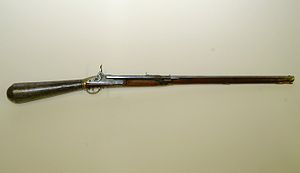Girandoni Air Rifle
| Girardoni air rifle | |
|---|---|

Girardoni system Austrian repeating air rifle, circa 1795, believed to have been taken on the Lewis and Clark Expedition
|
|
| Type | Air rifle |
| Place of origin |
|
| Service history | |
| In service | 1780–1815 |
| Used by |
Austrian Empire United States (Lewis and Clark) |
| Production history | |
| Designer | Bartholomäus Girardoni |
| Designed | 1779 or 1780 |
| Specifications | |
| Weight | 4.5 kg (9.9 lb) |
| Length | 120 cm (3.9 ft) |
|
|
|
| Caliber | .46 |
| Feed system | 20/21 round vertical hopper |
| Sights | Iron |
The Girardoni air rifle was an airgun designed by Tyrolian inventor Bartholomäus Girardoni circa 1779. The weapon was also known as the Windbüchse ("wind rifle" in German). One of the rifle's more famous associations is its use on the Lewis and Clark Expedition to explore and map the western part of North America in the early 1800s.
The Girardoni air rifle was in service with the Austrian army from 1780 to around 1815. The advantages of a high rate of fire, no smoke from propellants, and low muzzle report granted it initial acceptance, but it was eventually removed from service for several reasons. While the detachable air reservoir was capable of around 30 shots it took nearly 1,500 strokes of a hand pump to fill those reservoirs. Later, a wagon-mounted pump was provided. The reservoirs, made from hammered sheet iron held together with rivets and sealed by brazing, proved very difficult to manufacture using the techniques of the period and were always in short supply.
In addition, the weapon was very delicate and a small break in the reservoir could make it inoperable. Finally, it was very different from any other weapon of the time and any soldier using it needed to be highly trained.
The Lewis and Clark Expedition used the rifle in the demonstrations that they performed for nearly every Native American tribe they encountered on the expedition.
The rifle was 4 ft (1.2 m) long and weighed 10 lb (4.5 kg), about the same basic size and weight as other muskets of the time. It fired a .46 caliber ball (caliber is contested, original sources such as Dolleczek describe the caliber as 13mm (.51cal)) and it had a tubular, gravity-fed magazine with a capacity of 20 balls. This gravity operated design was such that the rifle had to be pointed upwards in order to drop each ball into the breech block. Unlike its contemporary, muzzle-loading muskets, which required the rifleman to stand up to reload with powder and ball, the shooter could reload a ball from the magazine by holding the rifle vertically while lying on his back and operating the ball delivery mechanism. The rifleman then could roll back into position to fire, allowing the rifleman to keep a "low profile". Contemporary regulations of 1788 required that each rifleman, in addition to the rifle itself, be equipped with three compressed air reservoirs (two spare and one attached to the rifle), cleaning stick, hand pump, lead ladle, and 100 lead balls, 1 in the chamber, 19 in the magazine built into the rifle and the remaining 80 in four tin tubes. Equipment not carried attached to the rifle was held in a special leather knapsack. It was also necessary to keep the leather gaskets of the reservoir moist in order to maintain a good seal and prevent leakage.
...
Wikipedia
